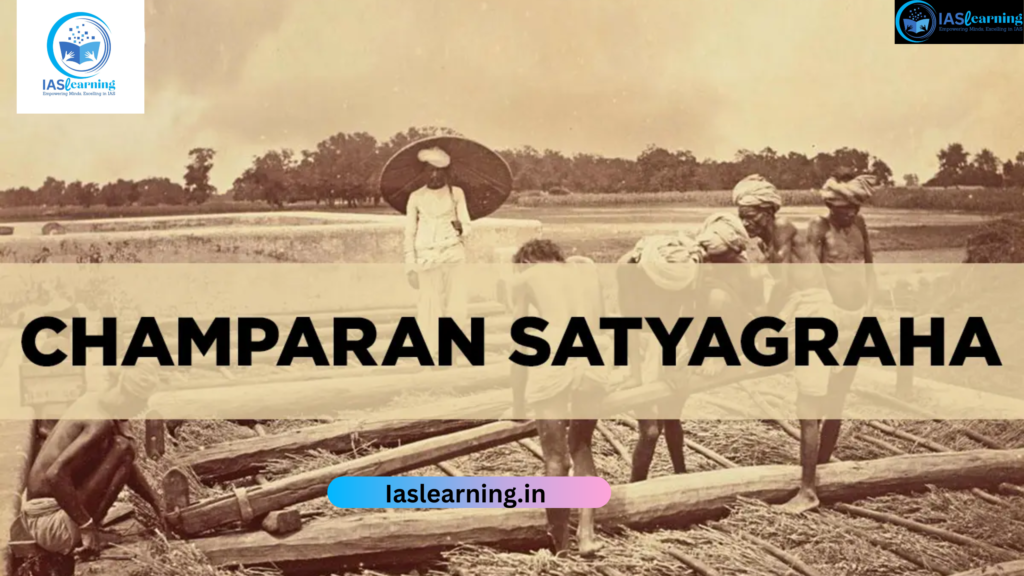Early in the nineteenth century, indigo cultivation was compelled on 3/20th of the cultivators’ lands in Champaran, Bihar, by agreements made by European planters. The system was called the Tinkathia system.
Turning point
- Indigo was driven off the market at the end of the nineteenth century by synthetic dyes made in Germany.
- The European planters of Champaran desired to relieve the peasants of their duty to grow indigo.
- By demanding increases in rent and other unlawful fees in exchange for the release, they attempted to take advantage of their necessity.
- Resistance first appeared in 1908.

Emergence of M.K. Gandhi
- Gandhi began a pan-Indian trip in 1915 after returning from South Africa with the goal of understanding the issues of the common people.
- In between, Champaran local Raj Kumar Shukla made the decision to accompany Gandhiji around the nation in an attempt to convince him to visit Champaran in order to look into the issue.
- Raj Kumar Shukla’s choice to bring Gandhiji to Champaran is a reflection of the reputation he had developed as a champion of the underprivileged and oppressed.
For more : American Revolution 1776, History, Causes, Timeline and its Impacts
History of the World Before 18th Century
Gandhiji’s criticism
- As Gandhiji arrived in Champaran, the Commissioner gave him the order to leave the region right away. To everyone’s surprise, however, Gandhiji declined and chose to accept the consequences of his disobedience.
- The Indian government decided not make concerns over it, so they gave the local government the order to back off and let Gandhiji continue with his investigation.
Enquiry by Gandhiji
After winning, Gandhiji started looking into the complaints of the peasantry. He and his associates visited the villages, recording the testimonies of the peasants and questioning them to ensure they were providing accurate information from dawn to sunset.
Gandhi’s companions were J.B. Kripalani, two young men from Gujarat named Mahadev Desai and Narhari Parikh, Brij Kishore, Rajendra Prasad, and other members of the Bihar intellectual.
For more : What is the concept of Nation and State?
What is Constitutionalism And Consitutional Morality
Outcomes
- Gandhiji had been suggested as a member of the Commission of Inquiry, which the government had established to look into the entire matter. Equipped with data collected from people living in rural areas, he had minimum difficulties convincing the Commission of the necessity of doing away with the tinkathia system.
- Additionally, that the peasants need to get payment for the unjustifiable increase in their debt.
- He agreed to a deal with the planters wherein they would only return 25% of the money they had unlawfully took from the peasants.
- Gandhiji responded to those who questioned why he did not want a complete refund by saying that the planters’ standing and reputation had already suffered enough from this reimbursement.
- Gandhi was right when he made this conclusion, and the planters completely abandoned the territory a decade later.
For more : India Employment Report 2024
Importance of Champaran Satyagraha
- Gandhiji’s first struggle on Indian soil was the Champaran Satyagraha, which followed his historic 20-year campaign for the rights of Indians in South Africa.
- One of the most important aspects of the Champaran Satyagraha is joining the peasant unrest into the Indian National Movement.
- It is often believed that Gandhi conducted his initial satyagraha experiments there before carrying them out elsewhere.
- It was swiftly followed by the 1918 Kheda Satyagraha against revenue improvements and the 1918 Ahmedabad workers’ strike against indigenous mill owners. Then came the 1919 all-India April Satyagraha against the Rowlatt Acts, and lastly the 1920–22 Khilafat campaign and non-cooperation.
- Prominent figures connected to the Champaran Satyagraha included Brajkishore Prasad, Shambhusharan Varma, Anugrah Narayan Sinha, and Ramnavmi Prasad.
